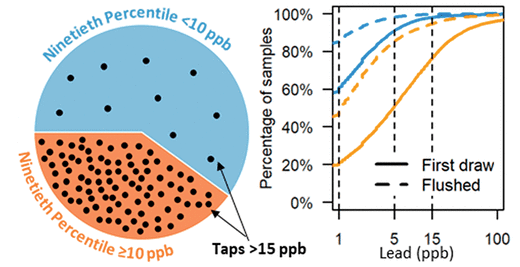
Hi all…an interesting paper on an “approach to classify a school’s lead risk, which could help water utilities and schools prioritizing testing and remediation efforts,” recently appeared in the journal ‘Environmental Science & Technology Letters’. The authors found that “fixtures releasing lead >1 ppb occurred in >90% of schools and represented 58% of first draws and 33% of 30-s flushed samples” vs. 12% of fixtures which had first draw lead >15 ppb and 3% after a 30 s flushing. The data were collected from the Massachusetts ‘Lead in School Drinking Water Database’.
If you are able to download the paper, Figure 1 provides the lead concentration in first draw and flushed samples for water fountains (n = 8,963 and 5,274) and non-water fountain fixtures (n = 13,309 and 11,260) at schools where fixture type was identified (n = 738). The large numbers of samples analyzed adds to the general reliability of the approach and findings. For more information on the USEPA proposed Revisions to the Lead and Copper Rule (LCR) see: https://www.epa.gov/ground-water-and-drinking-water/proposed-revisions-lead-and-copper-rule. For comparison, the Health Canada maximum acceptable concentration (MAC) for total lead in drinking water is 0.005 mg/L (5 μg/L), “based on a sample of water taken at the tap and using the appropriate protocol for the type of building being sampled. Every effort should be made to maintain lead levels in drinking water as low as reasonably achievable.”
Bill
____________________________________________________________
Using the Lead and Copper Rule Revisions Five-Sample Approach to Identify Schools with Increased Lead in Drinking Water Risks
McNamara Rome, Stephen Estes-Smargiassi, Sheldon V. Masters, Alan Roberson, John E. Tobiason, R. Edward Beighley, and Kelsey J. Pieper
Environ. Sci. Technol. Lett. 2022, 9, 1, 84–89. https://doi.org/10.1021/acs.estlett.1c00845
Abstract
“Despite public concern, the risk of lead exposure from schools remains poorly understood. The Lead and Copper Rule Revisions (LCRR) include, for the first time, a five-sample lead testing requirement for all elementary schools. However, the United States Environmental Protection Agency does not define school-wide lead risk or provide clear guidance on how results should be interpreted. Using the Massachusetts Lead in School Drinking Water Database, we explored the application of the LCRR sampling approach and provide insight into the magnitude and distribution of lead in water in Massachusetts public schools. We observed that 12% of fixtures had first draw lead >15 ppb and 3% after a 30 s flushing. Approximately 90% of fixtures with lead >15 ppb were clustered in 34% of schools. We determined a school-wide 90th percentile of 10 ppb closely approximated this clustering of problem fixtures and were able to identify schools with problem fixtures using the five-sample results with a confidence >90%. Fixtures releasing lead >1 ppb occurred in >90% of schools and represented 58% of first draws and 33% of 30-s flushed samples. Overall, our study provides an approach to classify a school’s lead risk, which could help water utilities and schools prioritizing testing and remediation efforts.”





